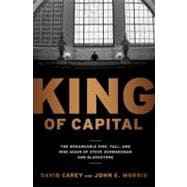
| The Debutants | p. 1 |
| Houdaille Magic, Lehman Angst | p. 13 |
| The Drexel Decade | p. 31 |
| Who Are You Guys? | p. 45 |
| Right on Track | p. 57 |
| Running Off the Rails | p. 72 |
| Presenting the Steve Schwarzman Show | p. 81 |
| End of an Era, Beginning of an Image Problem | p. 90 |
| Fresh Faces | p. 106 |
| The Divorces and a Battle of the Minds | p. 118 |
| Hanging Out New Shingles | p. 130 |
| Back in Business | p. 136 |
| Tuning in Profits | p. 148 |
| An Expensive Trip to Germany | p. 158 |
| Ahead of the Curve | p. 169 |
| Help Wanted | p. 179 |
| Good Chemistry, Perfect Timing | p. 196 |
| Cash Out, Ante Up Again | p. 208 |
| Wanted: Public Investors | p. 218 |
| Too Good to Be True | p. 224 |
| Office Party | p. 239 |
| Going Public-Very Public | p. 255 |
| What Goes Up Must Come Down | p. 278 |
| Paying the Piper | p. 286 |
| Value Builders or Quick-Buck Artists? | p. 301 |
| Follow the Money | p. 321 |
| Acknowledgments | p. 331 |
| Notes | p. 333 |
| Index | p. 379 |
| Table of Contents provided by Ingram. All Rights Reserved. |
The New copy of this book will include any supplemental materials advertised. Please check the title of the book to determine if it should include any access cards, study guides, lab manuals, CDs, etc.
The Used, Rental and eBook copies of this book are not guaranteed to include any supplemental materials. Typically, only the book itself is included. This is true even if the title states it includes any access cards, study guides, lab manuals, CDs, etc.